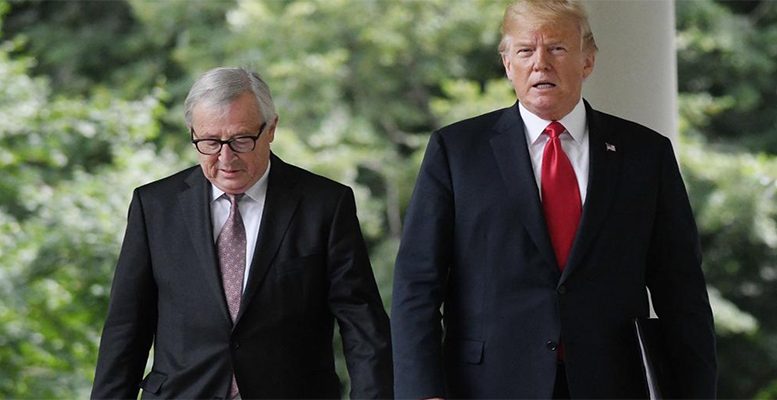BoAML do not think the Juncker-Trump trade agreement is a game changer. Rather they argue that the deal lowers the near-term risk of an auto trade war, supporting their cautious optimism on Europe. However, the deal is largely symbolic in nature, and as we have seen with past “ceasefires”, it may not last long.
Like all hand-shake deals, the auto ceasefire has a number of areas of ambiguity and some serious implementation challenges. Most importantly there are no numbers or dates in this agreement. How much of an increase in purchases is adequate? How quickly do results need to materialize? What constitutes “negotiations ”? Presumably the US will expect more than just talk, but progress. Perhaps the biggest missing ingredient is the core issue at hand: how will they resolve the auto dispute? As Commerce Secretary Ross made clear in follow-up comments, the US investigation of national security risks from imports of motor vehicles and parts continues unabated. In other words, they have agreed to a ceasefire while continuing to “ mobilize along the border.
Some aspects of the deal will be relatively easy to implement and others will not. According to analysts at BoAML, one must keep in mind that “commodities are traded on global markets and hence flows are determined by transportation costs.”
Unless the government intervenes, companies will simply buy from the lowest-price supplier and for commodities that are expensive to move (like LNG and crops) distance matters a lot. While China can easily command demands shifts, it is hard for European governments to over ride these cost considerations and force a quick increase in purchases of US goods. Until legislation passes, the EU needs to rely on natural market forces to do the job of increasing imports.
Given time, a gradual increase in LNG imports from the US is likely. Since the US started to allow exports in 2016, sales to Europe have jumped in percentage terms, but the dollar amount is still tiny (about $0.4bn last year). The challenge here is that Asia, not Europe, is the natural destination for US LNG.
It is much cheaper to export natural gas from Russia to the EU, especially once the fixed cost of pipelines has already been paid. The only reason for Europe to increase US LNG imports is if Russian supplies prove inadequate or if they worry about a lack of supply diversification.
Moreover, it will take time and a lot of investment to create the necessary infrastructure. Nonetheless an increase LNG trade is a win-win for both sides and some increase would have happened with or without the Juncker-Trump deal.
The soybean plan also faces challenges. On the one hand, the collapse in prices makes US soybeans very attractive to EU buyers. No trade deal is needed to incentivize EU companies to buy more from the US. On the other hand, Europe is a relatively small market for US soybeans: last year, EU imports were $1.7bn, while Chinese imports were $12.3bn. In opinion of BoAML , in part this is because “Europeans worry about the widespread use of genetic engineering (GMOs) in the US”.
In 2016 the EU approved imports of genetically modified soybeans, but food labels in Europe still have to indicate the presence of modified products, discouraging some consumer demand. It seems implausible to us that these labelling laws will change any time soon. As with LNG, some growth in US soybean exports to the EU seems likely but most of this would have happened without the deal.
Lowering industrial tariffs could prove very challenging. Tariffs for manufacturing products are already quite low for most pr oducts. According to the WTO they average 2.4% and 2.6% in the US and the EU, respectively. A bigger challenge comes from the WTO ’ s Most-Favored-Nation (MFN) rules. As Gilles Moec points out, it is hard to negotiate a strictly bilateral agreement because of the “free-rider” problem. WTO rules require that if the US and the EU lower their barriers vis-à-vis each other they also must lower their barriers vis-à-vis all other WTO members (including China), but without getting any reciprocal concessions.
Far from a win-win, this is a lose-lose for the US and the EU. At this stage, we don ’ t see how this part of the agreement can be done.
How long will the ceasefire last?
As BoAML’s discussion above suggests, the actual changes in trade flows under this deal are likely to be small, and most of the new flows would have happened anyway. In other words, the deal is largely symbolic. At the same time the most ambitious parts of the deal face a daunting road ahead. This suggests that trade tensions could re-emerge at any time.
This is not the only ceasefire we have seen in this “ two steps forward, one step backward ” march into a trade war. On April 3rd the Office of the US Trade Representative published its product list for potential China tariffs. On May 20th Treasury Secretary Mnuchin said tariffs were on hold while negotiations were ongoing, but just nine days later the tariffs were anno unced. On a similar note, initially a number of countries were exempted from steel and aluminium tariffs, but ultimately they went into effect. These switching positions have caused volatility in the equity market. Based on Bloomberg market commentary, since the start of the year there have been six days on which the S&P500 dropped significantly (at least 1%) on trade news and four days on which it rallied significantly on trade news. It has paid to be sceptical because the net market move on these ten days is -4.5%.





